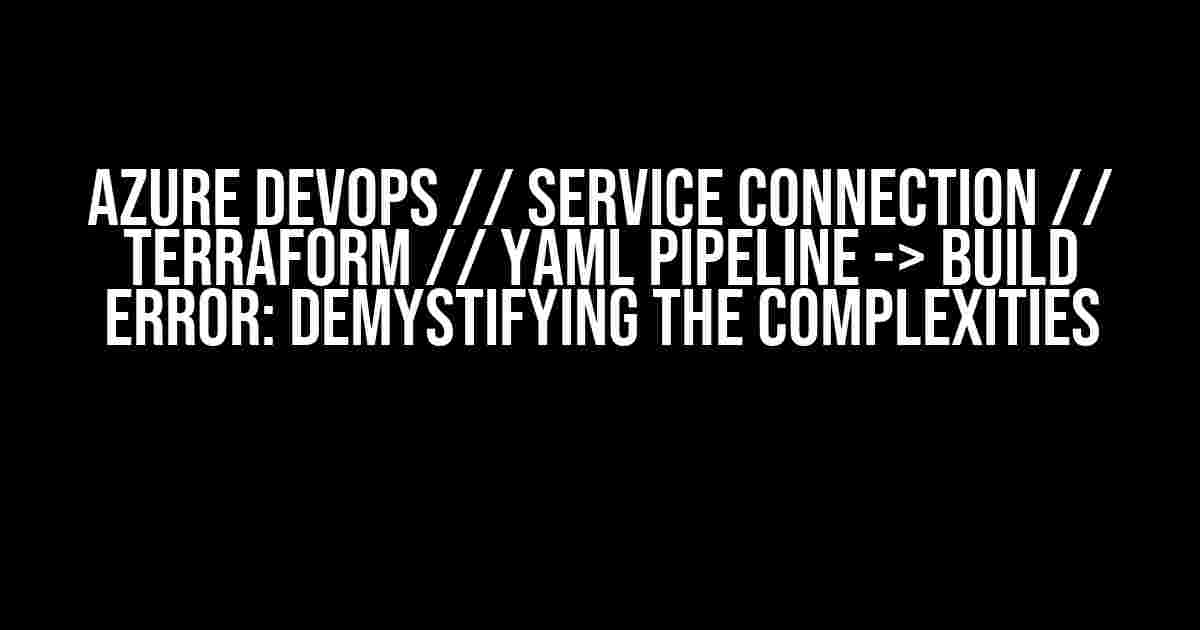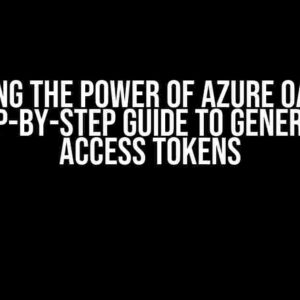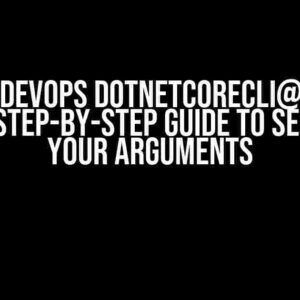Are you tired of banging your head against the wall because of the infamous “build error” in your Azure DevOps pipeline? Do you feel like you’ve tried every possible solution, but the error persists? Well, buckle up, friend, because we’re about to dive deep into the world of Azure DevOps, service connections, Terraform, and YAML pipelines to uncover the root cause of this pesky error.
Understanding the Landscape
Before we dive into the nitty-gritty, let’s take a step back and understand the components involved:
- Azure DevOps: A suite of services offered by Microsoft to facilitate collaborative software development, deployment, and delivery.
- Service Connection: A connection established between Azure DevOps and an external service, such as Azure, AWS, or GitHub, to enable seamless interaction.
- Terraform: An infrastructure-as-code tool that allows you to define and manage infrastructure resources using human-readable configuration files.
- YAML Pipeline: A workflow defined in YAML that automates the build, deployment, and testing of your application in Azure DevOps.
The Error: A Closer Look
The error we’re addressing typically manifests in the following manner:
##[error]Error: unable to execute terraform: azurerm provider version 2.34.0 does not support Azure DevOps pipeline ##[error]Script failed with return code: 1 ##[error]Error: The process '/usr/bin/terraform' failed with exit code 1
This error usually occurs when the Terraform task in your YAML pipeline fails to execute, citing incompatibility with the Azure DevOps pipeline.
Service Connection: The Unsung Hero
A service connection is the glue that binds Azure DevOps to your Terraform infrastructure. To resolve the error, we need to create a service connection that allows Terraform to interact with your Azure subscription:
Step 1: Create a Service Principal
In the Azure portal, navigate to Azure Active Directory and create a new service principal:
- Search for “App registrations” and click on “New registration”.
- Enter a name for your service principal and select “Web” as the platform.
- Under “Redirect URI”, enter
https://dev.azure.com. - Click “Register” to create the service principal.
Step 2: Assign Permissions
Assign the necessary permissions to the service principal:
- Navigate to the “API Permissions” tab and click “Add a permission”.
- Search for “Azure Service Management” and select the “user_impersonation” permission.
- Click “Add permission” to assign the permission.
Step 3: Create a Service Connection in Azure DevOps
In your Azure DevOps project, navigate to Pipelines -> Service connections and create a new service connection:
- Select “Azure Resource Manager” as the service connection type.
- Enter a name for the service connection and select the subscription you want to connect to.
- Under “Authentication”, select “Service principal” and enter the client ID, client secret, and tenant ID.
- Click “Verify and save” to create the service connection.
Terraform: The Infrastructure Maestro
Now that we have a service connection in place, let’s focus on Terraform:
Step 1: Install Terraform
In your Azure DevOps pipeline, add a task to install Terraform:
- task: TerraformInstaller@0
displayName: 'Install Terraform'
inputs:
terraformVersion: '0.14.11'
Step 2: Initialize Terraform
Initialize Terraform in your pipeline:
- task: TerraformTaskV1@1
displayName: 'Terraform Init'
inputs:
provider: 'azurerm'
command: 'init'
workingDirectory: '$(System.DefaultWorkingDirectory)'
serviceConnection: 'your-service-connection-name'
Step 3: Apply Terraform Configuration
Apply your Terraform configuration using the following task:
- task: TerraformTaskV1@1
displayName: 'Terraform Apply'
inputs:
provider: 'azurerm'
command: 'apply'
workingDirectory: '$(System.DefaultWorkingDirectory)'
serviceConnection: 'your-service-connection-name'
YAML Pipeline: The Orchestration Master
Now that we have our service connection and Terraform configuration in place, let’s create a YAML pipeline that brings everything together:
stages:
- build
- deploy
variables:
terraformVersion: '0.14.11'
serviceConnection: 'your-service-connection-name'
pool:
vmImage: 'ubuntu-latest'
steps:
- task: TerraformInstaller@0
displayName: 'Install Terraform'
inputs:
terraformVersion: $(terraformVersion)
- task: TerraformTaskV1@1
displayName: 'Terraform Init'
inputs:
provider: 'azurerm'
command: 'init'
workingDirectory: '$(System.DefaultWorkingDirectory)'
serviceConnection: $(serviceConnection)
- task: TerraformTaskV1@1
displayName: 'Terraform Apply'
inputs:
provider: 'azurerm'
command: 'apply'
workingDirectory: '$(System.DefaultWorkingDirectory)'
serviceConnection: $(serviceConnection)
Conclusion
In this article, we’ve explored the complexities of the Azure DevOps // Service Connection // Terraform // YAML pipeline -> build error and provided a step-by-step guide to resolving the issue. By creating a service connection, installing and initializing Terraform, and defining a YAML pipeline, you should now be able to automate the deployment of your infrastructure using Terraform and Azure DevOps.
Remember, the key to resolving this error lies in establishing a seamless connection between Azure DevOps and your Terraform infrastructure using a service connection. By following the instructions outlined in this article, you’ll be well on your way to streamlining your infrastructure deployment process.
| Component | Description |
|---|---|
| Azure DevOps | A suite of services for collaborative software development, deployment, and delivery. |
| Service Connection | A connection established between Azure DevOps and an external service to enable seamless interaction. |
| Terraform | An infrastructure-as-code tool that allows you to define and manage infrastructure resources using human-readable configuration files. |
| YAML Pipeline | A workflow defined in YAML that automates the build, deployment, and testing of your application in Azure DevOps. |
By demystifying the complexities of this error, we hope to have empowered you to take control of your infrastructure deployment process and unlock the full potential of Azure DevOps, service connections, Terraform, and YAML pipelines.
Frequently Asked Question
Got stuck with Azure DevOps, Service Connection, Terraform, and YAML Pipeline build errors? We’ve got you covered!
Q: Why is my Azure DevOps pipeline throwing a build error when trying to connect to my Azure subscription using a service connection?
A: Double-check your service connection configuration! Ensure that you’ve correctly set up the service principal, client ID, and client secret. Also, verify that the service principal has the necessary permissions to access your Azure subscription. If you’re still stuck, try re-creating the service connection or checking the Azure DevOps documentation for more guidance.
Q: How do I troubleshoot Terraform errors in my Azure DevOps YAML pipeline?
A: Start by reviewing the pipeline logs to identify the specific error message. You can also try running Terraform commands locally to isolate the issue. Ensure that your Terraform version is compatible with the Azure provider version. If you’re using a Terraform module, verify that it’s correctly configured. And, of course, don’t forget to check the official Terraform documentation for troubleshooting tips!
Q: What’s the best way to organize my Terraform configurations in an Azure DevOps YAML pipeline?
A: Structure your Terraform configurations using a modular approach, with separate files for each component (e.g., networking, compute, storage). Use Terraform workspaces to manage different environments (e.g., dev, prod). In your YAML pipeline, define separate tasks for Terraform init, plan, and apply, and use Azure DevOps variables to parameterize your Terraform configurations.
Q: How do I authenticate to my Azure subscription using Terraform in an Azure DevOps YAML pipeline?
A: You can use the Azure DevOps-provided `azureSubscription` task to authenticate to your Azure subscription. Alternatively, you can use the `AzureRM` Terraform provider and configure it using the `ARM_SUBSCRIPTION_ID`, `ARM_TENANT_ID`, and `ARM_CLIENT_ID` environment variables. Don’t forget to store your Azure credentials securely using Azure DevOps variables or secrets!
Q: What are some common mistakes to avoid when using Terraform in an Azure DevOps YAML pipeline?
A: Be mindful of state management, and make sure to configure Terraform to store its state in a secure, centralized location (e.g., Azure Storage). Avoid hardcoding sensitive information, and instead, use Azure DevOps variables or secrets. Don’t forget to test your Terraform configurations locally before running them in your pipeline. And, of course, keep your Terraform and Azure provider versions up-to-date!



